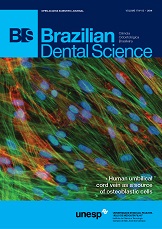Prevalence of oral lesions in elderly patients on oral cancer prevention campaigns in Parana state Brazil 1989-2013.
DOI:
https://doi.org/10.14295/bds.2014.v17i3.983Abstract
Objective: recently, there has been a rapid aging process of the world population. Despite of a longer permanence of natural teeth and a reduction of oral diseases caused by the improvement of life conditions and the provision of health care, the prevalence of oral diseases in the elderly is still considered significant. Therefore, the aim of this study is to evaluate the epidemiological profile of elderly patients (above 60 years old) attended in 25 years of campaigns oral cancer prevention in the Paraná state, Brazil, between 1989 and 2013. Material and Methods: Patients, volunteers, were evaluated during 25 years of oral cancer prevention by the campaign team and all patients were evaluated in a methodical way with inspection of all intra-oral areas. Results: a total of 22.909 patients were attended during the 25 years of projects. Of these, 6.134 were older than 60 years old, with appearance of 1.523 oral lesions during the examination and 4.611 patients had no oral alterations during the dentist evaluation, among those were found injuries by traumatic origin, inflammatory lesions and others types of injury. Conclusion: it is clear the necessity for specialized care and active surveillance of these patients, since it is a consensus in the literature that the best treatment is early diagnosis. It is also necessary the development of epidemiological studies of the elderly population, which are scarce and difficult to elaboration of plans for effective action to meet the specific demands of this age group.
Key words: oral cancer, Oral Examination, Oral Health, elderly cancer.
Downloads
Downloads
Additional Files
Published
How to Cite
Issue
Section
License
Brazilian Dental Science uses the Creative Commons (CC-BY 4.0) license, thus preserving the integrity of articles in an open access environment. The journal allows the author to retain publishing rights without restrictions.
=================




























